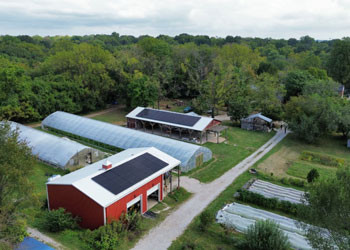
By Maeve Elder, Communication & Outreach Coordinator, Missouri Gateway Green Building Council
Photo Credit: Terry O’Connor
EarthDance Organic Farm School in Ferguson has taken a big step forward in its regenerative practices with a new solar array. The farm, which aims to empower local residents to grow and access healthy food through sustainable farming practices, community outreach, and educational programs, is committed to stewarding the land for future generations. The oldest farm west of the Mississippi, the farm was operated as an organic farm by the Mueller family since 1883 before EarthDance took over its management in 2008 after the last of the Muellers passed away. Through sustainable farming practices, community programs, and ecological restoration, EarthDance has developed a holistic model for a place-based organic farm that is committed to sustaining land, ecology and people. With clean energy, EarthDance deepens this commitment by reducing health and environmental impacts from fossil fuels.
EarthDance worked with Guarantee Electrical to install solar panels on its McBride Community Pavilion and George Fujii Harvest House. The solar array will generate 87% of the campus’s energy needs, reducing energy costs. It’s estimated that the panels will save more than $150,000 in avoided utility costs over the course of 30 years, and the system will have paid for itself after 14 years. In addition, EarthDance hopes to get 30% of the total project cost back using ‘direct pay’ through the Inflation Reduction Act (IRA). The ‘direct pay’ optionprovides tax-exempt entities such as governments, schools, and nonprofits with access to the IRA’s tax credits for clean energy projects. The savings on energy costs will directly benefit the community by being reinvested in EarthDance’s educational programs and sliding-scale produce sales.
With the solar array, EarthDance seeds its long-term vision of building a WaterWise Washroom. Developed with Missouri Gateway Green Building Council leadership and members during a charrette several years ago, the facility was envisioned to be “as efficient as a flower – self-sufficient when it comes to waste, water and energy,” shared Emily Andrews, MGGBC’s Executive Director. Buildings like this – termed ‘living buildings’ by the International Living Futures Institute – are designed to operate like a natural system, recycling resources and eliminating waste. Renewable energy from the solar array is the first piece of the planned facility, which will feature ecological waste management and rainwater recycling, providing sustainable restroom options for the farm’s many visitors, volunteers, and program participants.


